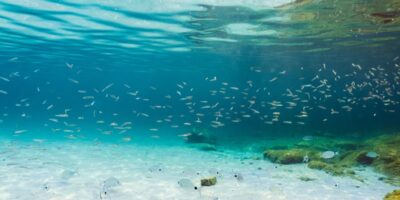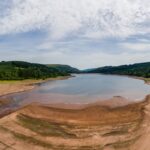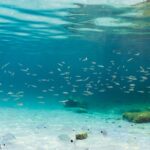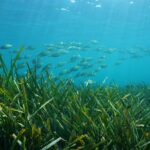With more than 25 years of experience in marine environmental research, Frank Thomsen answers our questions as to why we should care about the impacts of underwater noise on marine life.
Will you please introduce yourself?
Yes, my name is Frank Thomsen. I’ve been working for DHI for five and a half years, and I’ve been working in Marine & Environmental Research for about 26 years.
How do human sounds affect marine life?
First of all, we have to recognise that water is an ideal medium for sound transmission. It’s much more effective than air. Sound travels under water four times faster than in air. So consequently, sound ranges can be very large under water, and marine life has adapted really well to this. They produce all kinds of different sounds to communicate, to forage and to navigate with one another. For example, dolphins communicate over many kilometres under water, and fish communicate under water with sound. And even invertebrates seem to use sound. Human sound, for example, from an offshore windfarm or an offshore seismic survey, can interfere with all these functions.
How do animals react to this?
Well, they can react in many ways. Sound can actually mask the animals’ own signals, so they can’t hear or find one another again, because many of the sounds are contact calls. Then of course, they can act behaviourally, like wriggling their tails. But also very drastic reactions can occur by outright avoidance of larger areas. Then there can also be hearing loss due to sound exposure.
What measures do industries have to take to limit possible damage to marine life?
The first really important measure is to use a risk-based approach. In some cases, where there is actually no marine life present, industries can produce a lot of sound – but not affect any marine life. But of course, in situations where there is a very important habitat for the animal, industries may produce sound which can have adverse consequences. In these cases, industries have to do something about this sound. They can try to minimise the sound at the source – being more quiet by dampening the sound. For example, by putting wooden caps on pile drivers to reduce sound levels. There can also be measures taken to reduce sound that is coming out of an operation, for instance offshore wind pile driving. There can be bubble curtains or air bubbles around the pile driving activity. The sound there is reflected totally but reduced, so that marine life is not really affected. So there are a variety of measures the industry can take to reduce the impacts.
What kind of regulations do industries have to abide by?
Industries in Europe have to follow an environmental impact assessment, which is basically the risk-based approach. They have to assess the impact based on internationally accepted criteria – in some cases they have to do a modelling of the underwater sound. If they find that there’s a huge impact, they have to do something about it by minimising the sound exposure so as to not affect marine life.
And outside of Europe?
Outside of Europe, for example in the US, there’s a Marine Mammal Protection Act – it is very similar to what industries have to do in Europe. Beyond that, in some cases there is very little regulation. That’s why international bodies, such as the UN, are very important in advising regulations and frameworks to assessing impacts and actually save marine life across the planet.
What advice would you give to industries working in marine environment?
I would advise them to use an adequate framework. The risk-based approach that I mentioned earlier is really the best approach to assess impact – so they should adhere to that. They should also think that the investments they do today in order to minimise impacts are actually investments in the future, because we all rely on marine life to be well.
What are the main challenges for these industries?
The industries face challenges in terms of increased costs. Bubble curtain for an offshore wind farm is of course very cost extensive. Also, reducing survey time for seismic surveys can actually prolong them, and of course lead to increased costs. So industries are facing the problem of increased costs due to these mitigation measures. But again, these are investments in marine life. Industries should have an interest in actually protecting marine life.
Which findings in your work have left the strongest impression on you?
That’s a very good question. We found that fish that are exposed to pile driving sound in very large net pens, 40 diametres net pens in the Scottish Bay, where we played back the sound through an underwater speaker, would react by speeding up. They were swimming much faster. So we could actually show that at these sound levels that were comparable to very large ranges in the field, fish actually would react to pile driving with negative behavioural response. Back during my Ph.D days, I found that killer whales that have a dialect – group specific, family specific dialect in their communication – have a second kind of language which they all share and which is also learned. That was a very unique discovery.
Which main concerns about the future keep you up at night?
An increase of ambient background sound due to an increase of shipping and other more continuous sources. They change the acoustic habitat for marine life. Not so much the input of sounds that can act over long distances. This ambient sound increase changes the acoustic habitat, the area over which the animals communicate with one another. This can mean long-term changes to their acoustic environment, which I’m really concerned about.
Name one thing that is essential for a good partnership between you as a consultant, and the industry?
I think it is very important that we corporate with the industry also on research projects. We have initiated one research project together with the industry, where we look at the movement of whales and dolphins, and also fish in response to underwater sound using agent-based models. This is a very new technology, and we are very proud that we could work together with one very important industry partner on actually developing this feed of science further for better risk assessment.
What got you interested in marine life?
I guess I have always been interested in marine life and in animals in general. I was particularly fascinated by whales, so as a topic for my diploma thesis, I chose to study whales in Canadian waters, paddling with them with a kayak. That has led to a lot of really interesting experiences with the animals. And also my long-lasting fascination with the underwater world and especially with underwater sound.








